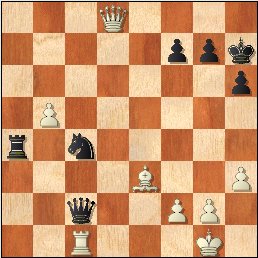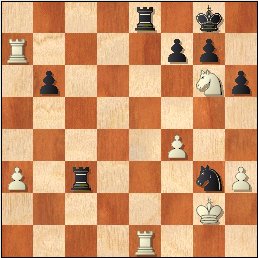


Improve your Chess via Active Learning
ACTIVE LEARNING is any strategy that involves students in doing things and thinking about the things they are doing (*)
You could study the following material either by skipping the test and going directly to the lecture. Or start by attempting to figure out on your own what is going on in each of the positions I will be talking about and then proceed to the lecture. If you chose the latter, spend time on each diagram and record your evaluation and move / plan for the side whose turn it is and sample variations. Then compare your ideas with mine. Let me know how you like the test and the lecture
Test yourself:
Level - beginner through advanced.
1. Check whose move it is / Read the question.
2. Evaluate position (i.e. White is Better, or Black is Winning, or Equal...)
3. Find the Best move and, if necessary, support it with variations. <<CALCULATE thoroughly!!>>
4. Answer the question (if there is a specific one)
 |
 |
 |
| #1. Black to Move. What would you play? Why? | #2. Black to Move. What would you play? Why? | #3. Black to Move. What would you play? Why? |
STOP - Lecture begins below.
"When having a Luft is not enough" .
From Wikipedia - "Luft, the German word for "air" (sometimes also "space" or "breath"), is used by some chess writers and commentators to denote a space left by a pawn move into which a castled king may move, especially such a space made with the intention of avoiding a back rank checkmate."
In this article, you will see an interesting pattern of how a R and a N are able to generate a solid pressure on the back rank, in spite of the K having a Luft.
|
#1. Black to Move.
|
#1. Sax,Gyula - Mariotti,Sergio (1978) Black is down a P, but have some initiative. Still, he is fighting for a draw. If White manages to trade the Qs without losing the b-P, he would have great winning chances. The back rank seems well under control - the R is there and the White K has a Luft. But... The game ended quickly - 36...Nxe3 37.Rxc2 Ra1+ 38.Kh2 Nf1+ 39.Kg1 1/2-1/2 The White K cant' escape the perpetual - 39...Ng3+ 40.Kh2 Nf1+, etc... Note that if Black had another piece or pawn attacking g3-square (e.g. h4-P), the White K would be checkmated in the corner - 39...Ng3+ 40.Kh2 Rh1# |
|
#2. Black to Move. |
#2. Training Position Black's R and his best trump - the a2-P are both under attack. But the response seems natural - 1...Rxb2, solving both problems. White does have a R check on the back rank, but Black has a Luft on h7. Well, not so fast - 2.Ra8+ Kh7 3.Nf8+! and the Black K can't escape! Hence a Draw. Note that once again, if the g6-square was under White's control, the Black K would be checkmated in the corner. Instead, Black should play 1...Rd8!, attacking the N and thus temporarily preventing the capture on a2. Once the N moves away, Black can capture on d4 and then invade the 2nd rank with a solid advantage. Practice this position with a friend or a computer. |
|
#3. Black to Move. |
#3. Orlov,Georgi - Psakhis,Lev (1992) White is in big trouble, but once again we see a defensive idea based on R+N perpetual on the back rank. White's last 30.Ne5-g6 stumped Black. Of course, the experienced grandmaster didn't fall for 30...Rxe1 31.Ra8+ Kh7 32.Nf8+ with a Draw. Instead, he played 30...Rd8, but... after 31.Rd7, couldn't escape the pesky R - 31...Ra8 32.Ra7 Rb8 33.Rb7 Rxb7 34.Re8+ Kh7 35.Nf8+ 1/2-1/2 The only two squares where the White R couldn't attack the Black R were not safe due to the N - ...Rf8? Nxf8 or ...Rc8 Ne7+ and Nxc8. If Black had recognized what White was planning, and wanted to play for a win, he could have played 30...Ne2!, sacrificing the exchange after 31.Ne7+ [31.Re7?! Re3] Rxe7 32.Rxe7 Nxf4+. Next he can capture either the a3-P or the h3-P and play or a win without any serious risk. Practice this position with a friend or a computer. |
==============================================================================================
Summary:
I hope that the three examples I presented were instructive and taught you this very interesting pattern of attacking the K along the back rank in spite of the Luft. Memorizing more patterns will help you to calculate easier and should improve your results.
==============================================================================================
What do you think about this article? How did you do? For comments,
corrections send email or use
this
form
More on chess training (serious and enlightening) in my books:
|
Special offer:
Chess
Exam package: Great Present - Chess Exam and Chess Exam Tactics,
Autographed and Personalized (when requested), 2010/2011 Chess
Cartoon Calendar ($8) + Free Shipping via Insured Media Mail -
|
|
Special offer: Get all three Chess Exam books autographed and personalized + meet me for 30 min of one-on-one Phone and/or Skype and/or ICC training session for $95 ($125 value), non-US - please add another $35 for shipping with insurance. |
|
|
Chess Exam and Training Guide (2004) |
Copyrighted @ 2010 Igor Khmelnitsky
For comments or permission to reprint please send inquires via email or this form
(*Bonwell, C., & Eison, J. (1991). Active learning: Creating excitement in the classroom (ASHE-ERIC Higher Education Report No. 1). Washington, DC: George Washington University, p. 2)